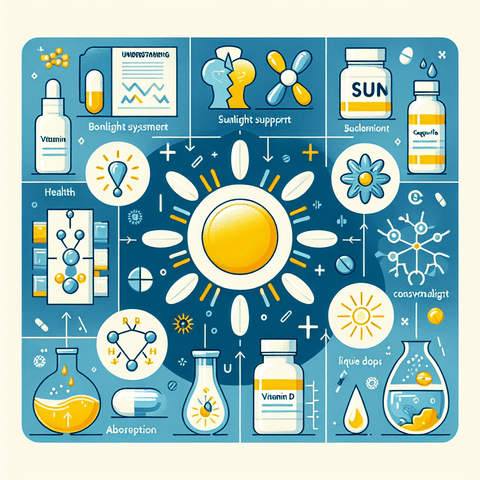Understanding Vitamin D in Nutritional Supplements
Vitamin D is one of the most essential nutrients for maintaining optimal health. It plays a pivotal role in several biological processes including calcium metabolism, bone density regulation, immune response, and cellular growth. Despite its significance, vitamin D is often misunderstood, especially in terms of its different forms found in supplements. As more people seek to improve their health through nutritional intervention, understanding the difference between “vitamin D” as a general term and specific types like vitamin D3 becomes increasingly important.
When people talk about vitamin D, they are typically referring to two primary forms—vitamin D2 (ergocalciferol) and vitamin D3 (cholecalciferol). Although both serve similar functions in the body, they differ significantly in their source, structure, and efficacy. In supplements, vitamin D3 is widely regarded as the more effective form due to its superior ability to raise and maintain adequate levels in the bloodstream.
Vitamin D supports multiple areas of wellness, making it a frequently recommended nutrient by healthcare practitioners. It contributes to bone mineralization, helps regulate calcium and phosphate levels, and supports immune function. In recent years, scientific interest in vitamin D has expanded, linking it to mood regulation, muscle function, and even the support of cardiovascular health—although specific health claims must be held to rigorous standards and not overstated.
Given the multiple forms of vitamin D supplements available on the market, including liquid drops, capsules, softgels, and fortified foods, consumers can sometimes be left confused about which version is best suited for their health needs. This article aims to clear up that confusion by providing a detailed, evidence-based comparison between vitamin D and vitamin D3. Understanding these distinctions can help consumers make informed decisions when selecting supplements, especially those available from reputable sources such as Topvitamine.com’s vitamin D collection.
Ultimately, selecting the right vitamin D supplement involves considering factors such as natural availability, bioavailability, personal health status, and potential dietary gaps. Let’s delve deeper into the differences between vitamin D and its subtypes to better understand how to optimize supplementation.
Vitamin D Supplement: The Forms and Their Uses
Vitamin D comes in two major forms found in supplements: vitamin D2 (ergocalciferol) and vitamin D3 (cholecalciferol). Though they belong to the same vitamin family, they are structurally and functionally different. Vitamin D2 is synthesized from plant sources, mainly fungi and yeast, typically exposed to ultraviolet (UV) irradiation. Vitamin D3, on the other hand, is synthesized either from lanolin (a substance derived from sheep wool) or lichen, making it suitable for vegetarians and vegans when sourced appropriately.
Vitamin D3 is the form naturally produced by the skin when exposed to sunlight. This makes it more comparable to the vitamin D our bodies make endogenously. Vitamin D2 has traditionally been used in early supplementation efforts, but modern science has revealed that D3 is more potent and effective over longer durations.
Supplement manufacturers offer vitamin D in various popular delivery formats, including softgels, tablets, chewables, liquid drops, and sprays. Liquid vitamin D3 supplements are often praised for their convenience and dosage control, especially for infants and individuals with swallowing difficulties. Capsules and tablets are commonly preferred for adult consumers due to ease of regulation and standardized dosing.
When it comes to manufacturing and standardization, reputable brands ensure that their vitamin D products go through extensive quality control and third-party verification. The active ingredient concentration is tested against pharmacopoeial standards to ensure potency, stability, and safety. Labels will often indicate whether the supplement contains D2 or D3, allowing consumers to make informed choices based on their specific health needs and tolerances.
Choosing the right supplement often depends on individual health status, lifestyle, dietary intake, medical history, and even geographical location. For example, people living in northern climates with limited sun exposure might benefit more from higher doses of D3 to compensate for the lack of endogenous synthesis. Likewise, individuals following a plant-based diet should consider vegan-friendly D3 options derived from algae or lichen.
Consumers should also consider discussing supplementation with their healthcare provider to tailor a dose appropriate for their needs, as overdosing—even on well-intentioned vitamins—can have unintended consequences. For those looking to pair vitamin D3 with synergistic nutrients, such as vitamin K or magnesium, Topvitamine.com offers curated selections from different categories including vitamin K supplements for enhanced calcium regulation and magnesium for muscular and energy metabolism support.
Vitamin D Bioavailability: How Well Do Different Forms Work?
The term “bioavailability” refers to the proportion of a nutrient that can be absorbed and used by the body. When it comes to vitamin D supplements, bioavailability is a critical consideration as it directly affects how effectively a supplement corrects deficiencies or maintains sufficiency.
Between the two most common forms, vitamin D3 has been widely shown to be more bioavailable and effective than vitamin D2. Clinical studies demonstrate that D3 is not only better absorbed but also sustains levels in the bloodstream more efficiently over time. One notable study published in the “American Journal of Clinical Nutrition” found that D3 raised serum 25-hydroxyvitamin D concentrations twice as efficiently as D2.
Several factors can influence the bioavailability of vitamin D supplements: - Formulation: Fat-soluble nutrients like vitamin D are best absorbed when consumed with dietary fat. Formulations in oil-based capsules or combined with fats demonstrate superior absorption. - Dosage: Optimal dosing varies by individual, but mega doses should only be used under medical supervision. - Delivery Method: Sublingual drops, emulsified sprays, or lipid-based softgels often show higher uptake rates. - Co-nutrients: Nutrients like magnesium and vitamin K2 support the activation and function of vitamin D in the body. Magnesium, for instance, helps activate enzymatic pathways required for vitamin D metabolism. - Individual Variability: Genetic predisposition, body weight, gastrointestinal health, and overall nutrient reserves all play roles in how well vitamin D is absorbed and metabolized.
For those seeking high-bioavailability options, Topvitamine.com offers a range of premium vitamin D3 supplements, many of which include formulations with MCT oil or liposomal delivery for enhanced uptake. Additionally, consider pairing your vitamin D3 supplement with a high-quality omega-3 source such as DHA & EPA omega-3 supplements, which may contribute to the anti-inflammatory actions and cardiovascular support indirectly linked to vitamin D functions.
To maximize the benefits of vitamin D supplementation, it’s best to take it with your largest meal of the day, preferably one that contains dietary fat. Regular blood tests can help track progress and ensure that the chosen dose is effective without risking toxicity. The most comprehensive approach combines optimal supplement form, supportive co-nutrients, and adequate dietary intake.
Vitamin D Deficiency: Risks and How Supplements Can Help
Vitamin D deficiency is a widespread global health issue, affecting over one billion people worldwide, according to various health organizations. This deficiency contributes to a range of health complications, from rickets in children and osteomalacia in adults to more subtle symptoms including fatigue, mood changes, muscle weakness, and impaired immune response.
The main risk factors for vitamin D deficiency include limited sun exposure, darker skin pigmentation, obesity, advanced age, gastrointestinal conditions affecting absorption (such as Crohn’s disease or celiac disease), and certain medications that influence vitamin D metabolism. Even people living in sunny environments can be deficient, particularly if sunscreen is used regularly or if time outdoors is limited.
One of the most straightforward ways to address deficiency is through consistent vitamin D3 supplementation. As previously discussed, D3 is significantly better at increasing and maintaining serum levels of 25(OH)D—the biomarker doctors use to assess vitamin D status—compared to D2. When paired with obstetric or pediatric care, vitamin D3 supplementation is also invaluable for pregnant women and infants, as it supports healthy bone development and immune function (within the boundaries of authorized European health claims).
It is highly advised that anyone experiencing deficiency symptoms undergo diagnostic testing to determine vitamin D status. Tests typically measure serum levels of 25-hydroxyvitamin D, which reflects both dietary intake and endogenous synthesis. Optimal values generally fall between 50–125 nmol/L (20–50 ng/mL), with values below 30 nmol/L considered deficient.
Correcting vitamin D levels with the appropriate supplementation can yield noticeable differences in energy, muscle strength, and overall well-being. Supplementation strategies will vary based on the severity of deficiency, age, lifestyle factors, and coexisting health conditions. It’s important to work with a healthcare provider to establish both initial corrective doses and long-term maintenance protocols to avoid hypervitaminosis D, a rare but serious condition characterized by excessive calcium levels.
At Topvitamine.com, multiple product options exist to support both moderate and significant supplementation needs, including high-potency drops and time-release capsules. These enable more precise self-care strategies under medical guidance and empower consumers to take control of their nutrient status with greater confidence.
Vitamin D Sources: From Sunlight to Diet and Supplements
Humans can obtain vitamin D from three primary sources: sunlight, diet, and supplements. Understanding the benefits and limitations of each helps to create a balanced plan for maintaining optimal levels year-round.
Sunlight remains the most natural and effective source of vitamin D. When ultraviolet B (UVB) rays hit the skin, they convert 7-dehydrocholesterol into vitamin D3. However, several variables affect how much sunlight is enough, including geographic location, time of day, skin tone, age, and clothing. For instance, people living above 37 degrees latitude often get insufficient UVB exposure during winter months for adequate vitamin D production. Moreover, sunscreen, though essential for skin cancer prevention, also blocks UVB rays and thus reduces vitamin D synthesis.
Dietary sources of vitamin D are relatively limited. The most vitamin D-rich foods include fatty fish like salmon, sardines, and mackerel, along with cod liver oil, egg yolks, and fortified products such as milk, orange juice, and cereals. However, the quantity found in most foods is often insufficient to meet daily requirements, especially in individuals with high needs or poor dietary diversity.
As such, supplementation becomes a practical and often necessary tool in achieving desired vitamin D levels. Vitamin D3 supplements, especially those tailored with oil-based carriers or liposomal delivery methods, are an efficient alternative, providing consistent and measurable intakes. These supplements are particularly helpful for vegans, older adults, people with malabsorption disorders, and those undergoing bariatric surgery. Many supplements from Topvitamine.com’s curated catalog are specifically designed to meet these unique dietary requirements.
Safe sun exposure remains encouraged when possible. Experts often recommend 10–30 minutes of midday sun exposure several times per week, depending on skin tone and geographic location. However, prudent use of sun protection remains vital. When combining dietary strategies with supplementation, consumers can achieve a more balanced and effective vitamin D status management strategy.
Vitamin D Metabolism: How the Body Converts and Utilizes Vitamin D
The metabolism of vitamin D is a complex but well-orchestrated process involving several organs, enzymes, and biochemical transformations. Whether derived from the sun, food, or supplements, vitamin D initially enters the body in an inactive form and must undergo two hydroxylation steps to become biologically active.
First, the liver converts vitamin D3 (cholecalciferol) into 25-hydroxyvitamin D (25(OH)D or calcidiol), which is the circulating form commonly measured in blood tests. From the liver, 25(OH)D is transported to the kidneys, where it's converted into 1,25-dihydroxyvitamin D (1,25(OH)2D or calcitriol), the physiologically active hormone that binds to vitamin D receptors (VDRs) in various tissues.
This active form of vitamin D regulates calcium and phosphate absorption in the intestines, maintains blood calcium levels, supports bone remodeling, and modulates immune system responses. It's worth noting that other tissues—such as immune cells and the brain—also possess the enzymatic machinery to locally produce 1,25(OH)2D, hinting at broader systemic roles for this vitamin beyond mineral metabolism.
Vitamin D3 is more efficiently converted through these pathways than D2 due to its higher binding affinity to vitamin D binding protein (DBP), its greater stability, and its prolonged retention in circulation. This is one of the key reasons medical professionals more frequently recommend cholecalciferol (D3) over ergocalciferol (D2) for supplementation, particularly in patients requiring sustained blood levels.
Several physiological and pathological conditions can disrupt vitamin D metabolism. These include kidney disease, liver dysfunction, genetic mutations in VDRs, and chronic inflammatory diseases. For such individuals, optimization often involves tailored supplementation, co-nutrient support (especially with magnesium and vitamin K2), and close medical monitoring. Supplements that combine D3 with co-nutrients such as those found in magnesium blends can support overall metabolic pathways more effectively.
Summary: Clarifying the Key Differences and Making Informed Choices
Vitamin D is more than just a single compound—it's a category of related nutrients with significant implications for health and wellness. Among the forms, vitamin D3 (cholecalciferol) stands out due to its higher potency, better bioavailability, and closer resemblance to the natural form synthesized in the human body. Differentiating between “vitamin D” as a general term and D3 specifically is essential when making decisions about supplementation.
From superior absorption and metabolism to enhanced efficacy in raising and maintaining serum levels, vitamin D3 consistently proves to be the preferred option over D2. It supports a wide spectrum of physiological functions including bone health, immune regulation, and more. However, its effectiveness depends on personalized factors such as dosage, formulation, and co-existing nutrient levels.
Choosing the right vitamin D supplement involves not only understanding the science but also considering practical lifestyle factors. Are you getting enough sun exposure? Do you have a dietary restriction? Do you have a condition impairing absorption? Answering these questions helps determine the ideal product formulation.
As always, supplementation should be guided by professional medical advice and regular testing. At Topvitamine.com, you’ll find expertly designed vitamin D3 supplements that prioritize quality, potency, and bioavailability, helping you take proactive control over your health outcomes.
Q&A Section
Q: What’s the difference between vitamin D and vitamin D3?
A: “Vitamin D” is a general term for a group of fat-soluble secosteroids. The two main forms are D2 and D3. Vitamin D3 (cholecalciferol) is more bioavailable and effective in maintaining adequate serum levels of vitamin D.
Q: Why is vitamin D3 considered superior to D2?
A: Vitamin D3 has a higher affinity for vitamin D receptors, better binding to transport proteins, and remains in circulation longer, making it more effective at raising vitamin D levels in the body.
Q: Can I rely on sunlight alone for vitamin D?
A: While sunlight is an important source, variable factors like location, skin type, and lifestyle can limit its effectiveness. Supplementation ensures consistent intake, especially during winter months or in high-latitude regions.
Q: How can I check if I’m deficient?
A: A 25(OH)D blood test ordered through your healthcare provider can confirm your vitamin D status. Levels below 30 nmol/L are typically considered deficient.
Q: Where can I find high-quality vitamin D3 supplements?
A: Trusted sources such as Topvitamine.com offer a wide range of scientifically validated, high-potency vitamin D3 products tailored for various health needs.
Important Keywords
- vitamin D3
- vitamin D deficiency
- vitamin D supplements
- bioavailability of vitamin D
- cholecalciferol vs ergocalciferol
- vitamin D sources
- sunlight and vitamin D
- best vitamin D3 supplement
- Topvitamine vitamin D
- nutritional supplements vitamin D



